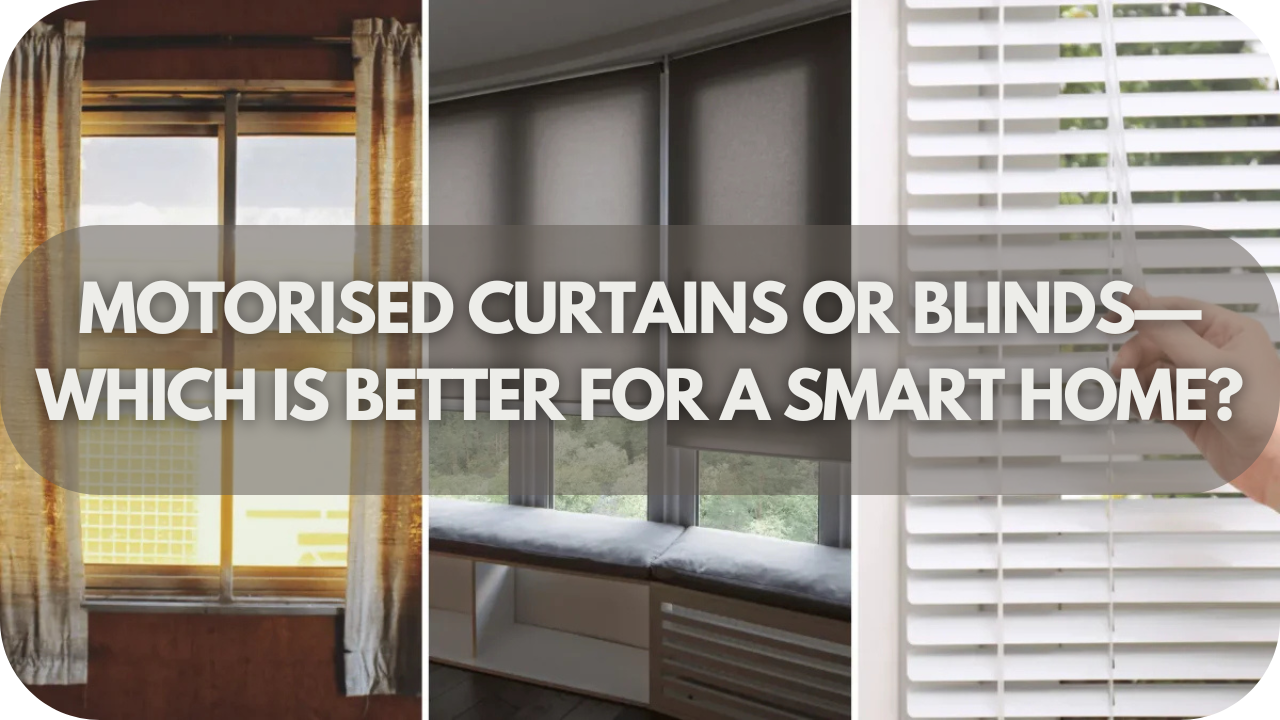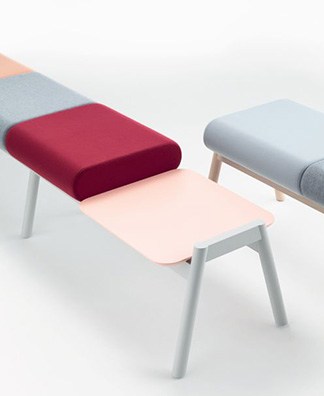Imagine waking up to natural light streaming in as your curtains glide open. Now, picture adjusting your blinds with a voice command, instantly tailoring the lighting and privacy.
As smart homes become more common, motorised window treatments transform everyday living, offering unmatched convenience and style.
But which is the better choice for your home: motorised curtains or blinds? In this article, we’ll compare the two to help you decide which option enhances your smart home experience.
Motorised Curtains or Blinds—Which is Better for a smart home?
Motorised curtains offer better insulation and are ideal for larger windows, while motorised blinds provide precise light control and are more versatile for different window sizes. The best choice depends on your home’s specific needs, with curtains suiting elegance and energy efficiency and blinds offering flexibility and modern style.
Functionality: How Do Motorised Curtains and Blinds Work?
Knowing how motorised curtains and blinds function is critical to making an informed choice. At their core, both systems use motors to automate the movement of the window coverings, allowing you to control them remotely.
Curtains are typically motorised to slide along a track, moving horizontally across the window, while motorised blinds operate by tilting slats or raising and lowering them vertically. But how does it all work?
Wireless control is one of the main features of motorised curtains and blinds. Whether using a remote, smartphone app, or voice command through systems like Alexa or Google Home, both options allow seamless operation.
Automation adds another layer of convenience. You can set schedules or sync them with smart home systems, adjusting for time of day or sunlight intensity.
The installation of motorised systems can vary slightly between the two. While curtains require a motorised track, blinds need motors integrated within their roller or tilt mechanism. Both options bring significant flexibility by offering programmable settings and integration with smart home devices.
Aesthetics: Which Option Offers More Style?
Both motorised curtains and blinds offer distinct advantages regarding style. Curtains often have an elegant, flowing look that adds softness and warmth to a room. Available in various fabrics, colours, and patterns, they can be customised to suit any interior design. But can blinds match this versatility?
Motorised blinds, in contrast, offer a more streamlined and modern aesthetic. Options like Venetian, roller, or Roman blinds provide a clean, minimalistic look that works well in contemporary spaces. Motorised blinds can be an ideal choice for those seeking a sleek finish.
Textures and materials also play a crucial role in defining style. While curtains may offer rich fabrics like velvet or linen, blinds are available in wood, aluminium, and other modern materials.
Light Control and Privacy
One of the most important factors when choosing between motorised curtains and blinds is how they manage light and privacy. Curtains typically offer complete coverage when drawn, providing total privacy and blocking out light entirely.
This feature can be invaluable for bedrooms or home theatres. However, are curtains the only option for complete control?
Blinds offer a more flexible approach. With adjustable slats, you can control the exact amount of light entering the room while maintaining privacy. This versatility makes blinds an excellent choice for spaces where you want more nuanced control over light and visibility. You can tilt the slats to let in natural light while preventing prying eyes from seeing in.
Automation enhances both options. You can programme motorised curtains to open fully at sunrise, flooding your room with daylight, or set blinds to adjust throughout the day, following the sun’s movement. Blinds may provide better light control in terms of precision, but curtains excel at offering total darkness and maximum privacy when needed.
Installation and Maintenance
Installation and maintenance are vital considerations when deciding between motorised curtains and blinds. Curtains require the installation of a motorised track or rod, which is typically mounted above the window.
This process can be more complex, especially for large or heavy curtains, and professional assistance may be needed to ensure proper alignment and functionality. Blinds, however, often involve integrating motors within the roller or tilt mechanism, which can be easier and quicker to install.
Maintaining these systems also differs. Curtains generally require regular cleaning, especially if made from fabric that attracts dust. Depending on the material, removing and washing them can be time-consuming.
Blinds tend to be lower maintenance, as they can be wiped clean with minimal effort, mainly if made from materials like aluminium or wood. However, motor components for both curtains and blinds may need occasional servicing to ensure smooth operation.
Regarding longevity, motorised curtains and blinds are designed for durability, but regular maintenance is essential to avoid mechanical issues. While blinds may have an edge in ease of installation and upkeep, curtains offer an elegant solution that might require more attention.
Cost Comparison
Cost is often a significant factor when choosing between motorised curtains and blinds. Curtains, particularly those made from high-end fabrics, can be more expensive upfront due to the material costs and the need for a motorised track.
Custom-made options or those requiring intricate installation may further drive up the price. But does the higher cost justify the investment?
Blinds offer a more affordable entry point. Standard motorised blinds, especially roller or Venetian types, usually cost less than curtains. The installation process for blinds is often less complex, which can also save on labour costs. However, premium materials like wooden blinds or advanced motor systems can still increase prices.
Maintenance expenses should also be factored in. Curtains incur higher long-term costs due to cleaning and fabric care, while blinds require less upkeep. Yet, both options may involve maintenance for the motor components over time.
Energy Efficiency
Energy efficiency is a crucial factor in the motorised curtains versus blinds debate. Curtains, especially thermal or insulated varieties, excel at keeping heat in during the winter and blocking out sunlight in the summer.
When fully drawn, they create a barrier that helps maintain a consistent temperature indoors, reducing the need for excessive heating or cooling. But are curtains the only option for saving energy?
Blinds, particularly honeycomb or cellular blinds, are designed to conserve energy. Their unique structure traps air, acting as an insulator, which helps in reducing energy consumption.
This feature makes blinds highly effective for keeping your home cool in summer and warm in winter. Additionally, the slat adjustment feature of blinds allows you to control the amount of sunlight entering the room, providing further flexibility in managing indoor temperatures.
Automating these systems can further enhance energy savings. Scheduling your curtains or blinds to close during the hottest part of the day or open during cooler periods can optimise your home’s energy efficiency. While both options offer energy-saving benefits, blinds may provide more nuanced control due to their adjustability.
Best Room Applications: Where Each Option Shines
Depending on their function, motorised curtains or blinds may benefit different rooms in your home. In the living room, motorised curtains can add a touch of elegance and luxury. Their soft, flowing fabric creates a welcoming ambience, making them ideal for spaces where aesthetics matter. But is this the best choice for every room?
Blinds offer a more practical solution, particularly in home offices or kitchens. Their sleek, minimal design perfectly suits the need for precise light control and a modern, streamlined appearance. Blinds work exceptionally well in spaces where privacy and light management, such as offices or bathrooms, need to be balanced throughout the day.
In bedrooms, motorised curtains often take the lead. They provide complete darkness when needed and can be paired with blackout fabrics for maximum privacy and restful sleep. On the other hand, blinds in communal areas like dining rooms or lounges offer a stylish yet functional way to manage light without compromising on design.
Integration with Other Smart Systems
Motorised curtains and blinds are key to integrating with other smart systems. Both options can seamlessly connect with popular smart home ecosystems like Google Home, Amazon Alexa, and Apple HomeKit. But how does this integration enhance your home experience?
Voice control is one of the most convenient features of smart window treatments. You can open or close your curtains or blinds without lifting a finger with a simple command. This adds an extra layer of convenience, especially in homes where accessibility and ease of use are priorities.
Additionally, both motorised curtains and blinds can be integrated with automated lighting systems, allowing them to adjust in sync with your lights or according to the time of day.
Scheduling is another feature that makes integration valuable. For example, you can set your blinds or curtains to open at sunrise and close at sunset, contributing to energy savings and convenience.
Which Option is Right for Your Smart Home?
Deciding between motorised curtains and blinds for your smart home depends on your priorities. If you’re looking for a luxurious, soft aesthetic, motorised curtains are often preferred. Their ability to block out light makes them ideal for bedrooms and cinema rooms. But does that mean they’re always the best option?
On the other hand, motorised blinds offer a sleek, modern appearance that complements minimalist or contemporary designs. Their ability to fine-tune light control gives blinds an edge in spaces like home offices or kitchens where partial light and privacy are needed throughout the day.
The adjustability of slats makes them highly versatile, catering to different lighting preferences at any time.
Maintenance should also factor into your decision. Curtains, significantly heavier fabrics, require more cleaning effort, while blinds are generally easier to maintain. When considering energy efficiency, both options perform well, but blinds with their insulating slats may provide a slight advantage.
Conclusion
Choosing between motorised curtains and blinds ultimately hinges on your style, functionality, and privacy needs.
Both elevate your smart home experience, but each shines in different spaces. Ready to transform your home? Explore our range of motorised curtains and blinds to find the perfect match for your smart living setup today!


